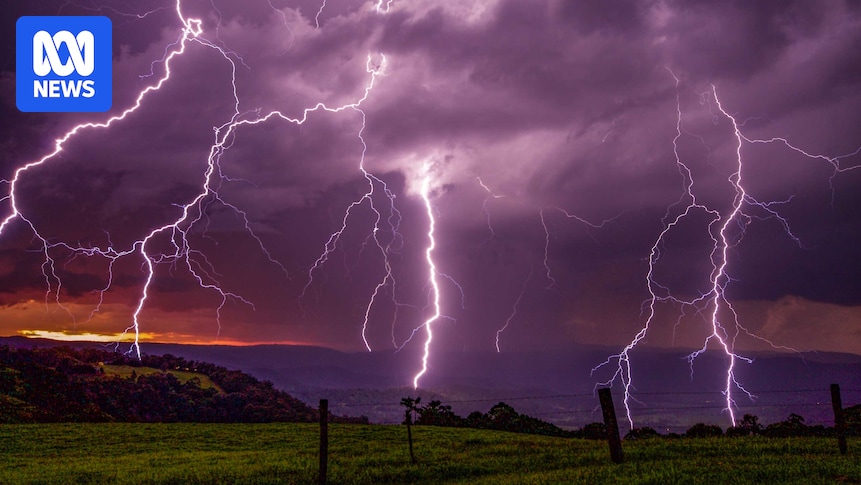As thunderstorms exploded across several parts of Australia this week, photographers jumped into action.
Stunning storm photos emerged from parts of Victoria, New South Wales, South Australia and Western Australia, many with a distinct purple hue.
Lightning lights up a thunderstorm with a purple hue. (Supplied: Jordan Cantelo)
Lightning can come in many different colours, including yellow, brown, pink and red, depending on environmental factors.
But Bureau of Meterology senior forecaster Jessica Lingard said purple was the most common colour.
Hotter lightning more likely to be purple
Ms Lingard said the humidity in the atmosphere, water vapour, gas in the atmosphere and distance of the observer from the storm could affect the colour of lightning.
Chris O’Connell captured this image of a storm cloud in the Wimmerra on Thursday morning. (Supplied: Chris O’Connell)
“Like a rainbow, it’s the light from lightning that refracts in the spectrum,” she said.
A thunderstorm over Kangarilla, just south of Adelaide, lighting up the sky on Monday night. (Supplied: Jenny Throrpe)
“The hotter the lightning is the more likely we’ll see those blues and purples than reds or pinks.”
Ms Lingard said lightning was made up of highly charged electrons that “zip through the atmosphere”.
Bureau of Meteorology senior forecaster Jessica Lingard. (ABC News: Kenith Png)
“Lightning excites all the other molecules in the air by ionising it, which makes them quickly release photons or visible light,” she said.
“Because our atmosphere is mainly comprised of nitrogen and atmosphere, we tend to see a combination of violets, reds and blues.”
Capturing colours on camera
Western Australian photographer Jordan Cantelo chases storms across the state and has captured purple lightning on camera.
Thunderstorms and lightning often appear purple due to a natural phenomenon. (Supplied: Jordan Cantelo)
“It’s all different colours, purple I’ve seen before particularly high in the atmosphere,” he said.
“Usually I see white with the naked eye but occasionally you see the purple … you see it more in the camera.
Jordan Cantelo says people often think thunderstorm photos are manipulated when they show striking colours. (ABC Midwest & Wheatbelt: Chris Lewis)
“When you see the colours on camera you think, ‘Wow’.
“People think you manipulate the photos but it’s just the lightning colour popping out.”
Mr Cantelo said capturing a storm build and produce lightning was incredible to witness.
“Sitting myself under a thunderstorm … it’s amazing to see the big cloud tower up 40,000 feet into the air, it’s awesome,” he said.
What causes thunder?
The rumble or crack from a lightning strike is from the air “exploding”.
“When a lightning bolt moves through the air [it] heats up the surrounding air to five times the temperature of the surface of the sun,” Ms Lingard said.
“It causes the air to explosively expand, which is the sound of thunder we hear.”
A lightning strike over Sydney’s CBD with a purple hue. (Supplied: Bruce Willis)
Counting between a flash of lightning and the rumble of thunder can help indicate how far away it is, according to Ms Lingard.
“A good rule of thumb is about three seconds per kilometre from flash to thunder,” Ms Lingard said.
